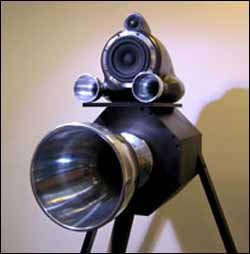Winning sound with Ariane technology

Haliaetus’ loudspeaker for large studios
The use of Ariane launcher technology has blasted a French loudspeaker firm into a winning position. Haliaetus Technologies won a top prize in a prestigious competition for creative start-ups with an innovative loudspeaker that uses rocket nozzle shapes to reduce sound distortion.
Three years ago, Jean-Pierre Morkerken, an acoustic researcher from the French lab ’Laboratoire d’Acoustique Musicale’, at the ’University Pierre and Marie Curie’ in Paris, got the idea to adapt rocket nozzle profiles to loudspeakers boxes. He tried it out with surprising results. The invention reduced quality losses due to aerodynamical effects, and allowed better sound for a smaller size of speaker.
For the Ariane rocket, the shape of the nozzles is crucial to secure the best gas flow with no turbulences during take off. For speakers it is essential to make the sound waves propagate with as little turbulence, to avoid distortion. The objective of the rocket design engineers is very similar to the one of their acoustic colleagues – to reduce turbulence.
“I have two passions: acoustics and aeronautics. Knowing how rockets and their nozzles are designed to work best and understanding well the tricky elements of loudspeaker’s sound reproduction, I just had to add the two!” explains Jean-Pierre Morkerken.
A start-up company was created, Haliaetus Technologies SAS, and following further research and development, the team has now finished industrial prototypes thanks to support from ESA Technology Transfer Programme (TTP), its French TTP-partner Nodal Consultants and the French government’s innovation programme.
“We are now preparing for a commercial launch of our products on the market in October 2004,” adds Raphaël de Thoury, Manager of Haliaetus. “Our initial loudspeakers are designed specially for professional use and studios.”
“It may seem a long way from Ariane boosters to concert loudspeaker. But after 200 transfers of space technology, I have learned not to be surprised. We have so many times seen the most unexpected spin-offs providing fantastic solutions on Earth,” says Pierre Brisson, Head of ESA’s TTP. “After hearing the sound of the Haliaetus speaker I am sure that this space technology transfer will be a great success.”
The project has just won a special award in the 2004 creative contest organized by the French Ministry of Research for small companies. Of the more than 1400 competitors, the Haliaetus loudspeaker came second. The prize will be used in a research and development programme to build and put a product to the mass-market by next year, targeting hi-fi enthusiasts.
So be prepared – rockets are coming to your living room!
Media Contact
More Information:
http://www.esa.intAll latest news from the category: Communications Media
Engineering and research-driven innovations in the field of communications are addressed here, in addition to business developments in the field of media-wide communications.
innovations-report offers informative reports and articles related to interactive media, media management, digital television, E-business, online advertising and information and communications technologies.
Newest articles

Superradiant atoms could push the boundaries of how precisely time can be measured
Superradiant atoms can help us measure time more precisely than ever. In a new study, researchers from the University of Copenhagen present a new method for measuring the time interval,…

Ion thermoelectric conversion devices for near room temperature
The electrode sheet of the thermoelectric device consists of ionic hydrogel, which is sandwiched between the electrodes to form, and the Prussian blue on the electrode undergoes a redox reaction…

Zap Energy achieves 37-million-degree temperatures in a compact device
New publication reports record electron temperatures for a small-scale, sheared-flow-stabilized Z-pinch fusion device. In the nine decades since humans first produced fusion reactions, only a few fusion technologies have demonstrated…





















